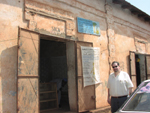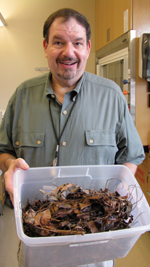|
By
Dawn Brazell
Public Relations
Indiana Jones, move over.
MUSC has its own globe trotter searching for international finds. With
a treasure trove of barks, plants and fruit extracts stashed on shelves
in his laboratory, Michael J. Wargovich, Ph.D., loves roaming the globe
in pursuit of natural plants and products that may hold clues to
prevention and treatment of cancer.
 Researchers
Vondina Moseley, Dr. Jay Morris, Becky Weber and Dr. Michael Wargovich
strike a pose in their lab. Researchers
Vondina Moseley, Dr. Jay Morris, Becky Weber and Dr. Michael Wargovich
strike a pose in their lab.
The ethnobotanist, who
recently finished submitting six grants in two weeks, is a professor of
cell and molecular pharmacology at MUSC, and has a wait list of
students who want to work in his laboratory. Arriving at MUSC four
years ago after 15 years at MD Anderson Cancer Center in Houston,
Wargovich has been a chemoprevention researcher for more than 20 years.
He started with pharmaceutical drugs and then moved to dietary
compounds after noticing interesting associations with what people eat
in other areas of the world and lower incidences of cancer.
His work studying West
African plants for specific kinds of anticancer activity, especially
COX inhibition, on colon cancer cell lines recently was featured in the
latest National Cancer Institute's overview of promising research in
complementary and alternative medicine.
 Dr.
Michael Wargovich visits Kankan, Republic of Guinea, where he collected
15 medicinal plants. Dr.
Michael Wargovich visits Kankan, Republic of Guinea, where he collected
15 medicinal plants.
Wargovich's interest in
ethnobotany got a boost when he went to the Republic of Guinea, West
Africa in 1999-2000 because of research being done by his wife, Joan
Cunningham, Ph.D., a breast cancer researcher and epidemiologist who
now works at MUSC. While there, he met a traditional healer who had a
detailed book of all the medicines they had derived from natural plants
in that region.
"I felt like Indiana Jones
who had been given the key to the city. I asked them if it would be
possible to get some of those plants, and they said sure, no problem,
and that started it. We brought some of those plants back," he said
pointing to bins stored in his lab. "One plant we found has a natural
pain reliever and those are strongly associated with reduced risk for
cancer."
The hope is that some of
these natural compounds can reduce inflammation with the effectiveness
of nonsteroidal anti-inflammatory drugs but without the toxicity and
side effects that have required the drugs to be pulled off the market
or be limited in use because of side effects. The bark of the Senegal
mahogany tree, for example, has a natural compound that works similar
to Celebrex, and he hopes to secure funding to get the bark from
Australia for study.
Wargovich said it's interesting to note that many research studies
suggest that advanced, affluent nations have increased risks for cancer.
"I don't believe that's
entirely true, but what is true is that many of the cultures that we
believe are protected from cancer and other major diseases may be
protected because naturally in their diet and culture are
anti-inflammatory compounds. We're not built to handle the high calorie
and high carbohydrate foods we take in every day, so this sets up a
long period of inflammation."
Diet
Connection
Researchers are excited about making the link between this long-term
inflammation and how it sets the stage for such diseases as cancer,
heart disease, obesity, Alzheimer's disease and basically any disease
that has an "itis" at the end, he said. He has talked with his
international colleagues who live in places that naturally have diets
rich in anti-inflammatory compounds. His colleagues worry that as their
cultures westernize and more fast-food options arrive that certain
disease will increase.
They have reason to worry.
"All the diseases I mentioned before are on a huge upswing."
Wargovich
holds up a bin of Khaya senegalensis leaves and bark. Known as mahogany
tree, the plant may contain anit-inflammatory agents. To view a video
on Wargovich, visit http://bit.ly/MUSC_Wargovich.
Asked routinely what foods
cause cancer, Wargovich said the more interesting question to him is
what have we removed from our diets that was potentially protective
during the last 100 years. One research area he's excited about is
investigating how green tea and vitamin D act in conjunction as
combatants against inflammation.
There is a relationship
with some diseases and how far north a population lives, such as in the
case of colitis or inflammation of the colon that affects 2 million
Americans each year, he said. The farther North, the more the
prevalence. What researchers are finding is that patients who have this
disease generally have very low levels of vitamin D in their blood.
"As our culture has moved
indoors over the years, most of us are chronically low. Vitamin D is
the lock and key that controls inflammatory processes. Everything in
molecular biology seems to be a switch. It's on or it's off. For
instance, in cancer cells, they corrupt this inflammatory pathway to
survive. They do that by turning off the genes that control
inflammation. The discovery we've made in this lab is that one of the
compounds in green tea can actually turn the control genes back on to
control inflammation."
 Dr. Jay
Morris studies green tea polyphenols. Dr. Jay
Morris studies green tea polyphenols.
Wargovich compares it to a
car that has lost its brakes. Cancer cells use gene silencing to be
able to cut through the brakes and accelerate through the body.
"What green tea does is
put the brake system back on line, to put it simply, which is a very
exciting hypothesis that we're pursuing in the lab. We think if the
green tea compounds make the vitamin D receptor more capable, then it's
going to be more receptive to having vitamin D coming in from other
sources."
Another promising area
involves exploring food extracts from South American fruits that few
Americans have even seen. He holds up a sheet with some of his
favorites, including pitahaya, carambolo, borojo, uchuva, naranjilla
and others. Many South America areas have diets that feature native
fruits and juice drinks that are packed with anti-inflammatory
compounds. "A lot of them are in the passion fruit family. They are the
most remarkable, wonderful tasting fruits you could ever imagine."
Garden
Delights
Down the road, Wargovich hopes to work as part of a team to develop a
cancer prevention cuisine, a "culinary experience" for outpatient
cancer patients featuring food that is loaded with herbs and spices.
People will not change their diets to reflect a developing world's type
of diet, but they will take the bits and pieces that they like, he
said. The concept is let's put these things into something that people
will find readily acceptable with scientifically proven compounds.
"I think it's a great
concept. Imagine if you came to a cancer center and instead of being
told to eat healthy, you're given an actual meal plan with ingredients
that have been studied scientifically. There's a spice from the Indian
culture that's extremely exciting called tumeric. Why not have stews or
hamburgers with turmeric in them? Why not have a chef's mind go wild in
creating a culinary experience with turmeric?"
An avid gardener,
Wargovich glows as he describes the idea. Everyone in Wargovich's lab
participates in community-supported agriculture and Wargovich looks for
ways to adopt the healthy habits of other cultures. He grows stevia,
perilla, basil, mint and other plants at home and drinks tea every day,
he said.
"I love gardening, but I'm
a cancer researcher, so this field lets me marry them together."
5 Top Tips from
Wargovich to Create a Cancer Prevention Diet
1. Go Local.
We're really driving
home the vegetable-based diet and locally grown. We depend too much on
things coming from all over the world and who knows how long it has
been in transit.
2.
Go Natural.
Take advantage of anything that is natural – especially beverages. From
a chemistry point of view, any kind of tea is good. Try different
fruits and look for color.
3.
Spice it Up.
Really think about herbs and spices. These are outrageously high in
antioxidants and anti-inflammatories. Garlic and cinnamon and clove –
turmeric – all those things that have a little bit of buzz and a taste
to them – that's a chemical signal that there's something pretty potent
in them.
4.
Take the Long View.
There's no quick fix here. When I talk about exposure to teas and
vegetables, that needs to be daily. The preventative effect of food
comes from long-term, consistent exposure to healthy foods.
5.
Find Balance.
It's OK to enjoy the foods you like to enjoy, but balance it off
knowing there's a cost to it. If you enjoy yourself today and you know
those foods aren't that healthy, then tomorrow do something else. For
those of us who study cancer, the whole disease is something out of
balance. It breaks all the regulatory bonds that keep it from spreading.
|



 Researchers
Vondina Moseley, Dr. Jay Morris, Becky Weber and Dr. Michael Wargovich
strike a pose in their lab.
Researchers
Vondina Moseley, Dr. Jay Morris, Becky Weber and Dr. Michael Wargovich
strike a pose in their lab. Dr.
Michael Wargovich visits Kankan, Republic of Guinea, where he collected
15 medicinal plants.
Dr.
Michael Wargovich visits Kankan, Republic of Guinea, where he collected
15 medicinal plants.
 Dr. Jay
Morris studies green tea polyphenols.
Dr. Jay
Morris studies green tea polyphenols.